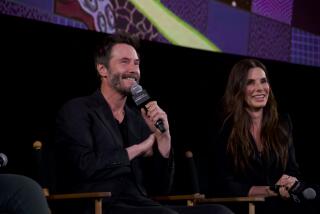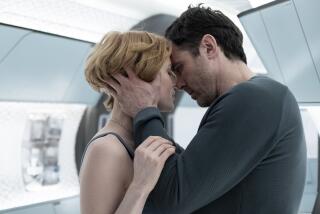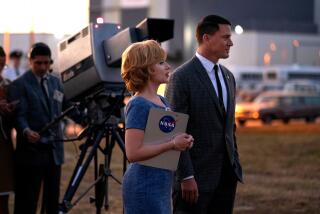‘Gravity’ takes Alfonso Cuaron and crew on a tricky joy ride
The biggest obstacle to making Alfonso Cuarón’s space epic “Gravity” was the natural phenomenon itself.
The Mexican director, along with his longtime cinematographer Emmanuel Lubezki, visual effects supervisor Tim Webber and a crew that numbered in the hundreds, spent four years conquering the forces of gravity in the Sandra Bullock-George Clooney drama due out Oct. 4.
The film stars Bullock as an engineer with little space experience who must rely on veteran astronaut Matt Kowalsky (Clooney) when satellite debris cuts them loose in space.
SNEAKS: Movie trailers, full coverage
Though traditional visual effects have often sufficed for movies set beyond Earth’s atmosphere, Cuarón’s vision would find the astronauts outside their shuttle for most of the film that coupled with his penchant for the long, multi-minute camera shot would require some new technology to realistically simulate zero gravity for such extended periods.
“The biggest miscalculation was that I thought everything was going to be more straightforward,” said Cuarón. Turns out nothing was.
The team tested several technologies for the job, Cuarón said, so different in nature that all they had in common was that they all used “computers and robots, and they were all very painful for the actors.”
PHOTOS: Fall Movie Sneaks 2013
The solution they settled on was to put the actors into contraptions that would spin them around just enough to make it look like they are floating while the cameras and lights did the majority of the visual work. To do so, Webber invented “The Lightbox” after Lubezki, who for the first time pre-lighted an entire film inside a computer, was inspired by the lighting design at a Peter Gabriel concert at the Hollywood Bowl.
In a studio outside London, Webber and his staff created a roughly 20-foot-tall, 10-foot-wide cube filled with LED lights in segmented panels that act as projection screens lining the walls, ceiling and floor. Each actor in turn stood in a “tilt-a-rig” — something akin to a cherry picker bucket that could tilt Bullock and Clooney forward and backward and spin them in various ways to create the illusion of tumbling head over heels, adrift in the stars. The camera, mounted on a giant robotic arm, was capable of swooping in and out, shooting from above and below, all adding to the effect of untethered movement.
“We could project an image of the Earth onto the screens spinning around Sandra,” added Webber. “That way, we could have lights, and bounce lights off the space ship and all around her and it was very easy to tweak on set.”
It wasn’t all a joy ride for the actors though, especially in scenes set inside the shuttle where Bullock floats from room to room, pushing off walls and flying through tunnels. To get the proper gravity-defying movements, the actress was strung up like a marionette, with actual puppeteers pulling the wires to control her limbs.
Cuarón, who wrote the script with his son Jonas, compares the challenging shoot to a long sea voyage.
“Before you know it, you find yourself in the middle of the ocean. You don’t know how far away you are from land and the only choice you have is to keep on moving.”
More to Read
Only good movies
Get the Indie Focus newsletter, Mark Olsen's weekly guide to the world of cinema.
You may occasionally receive promotional content from the Los Angeles Times.










